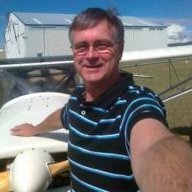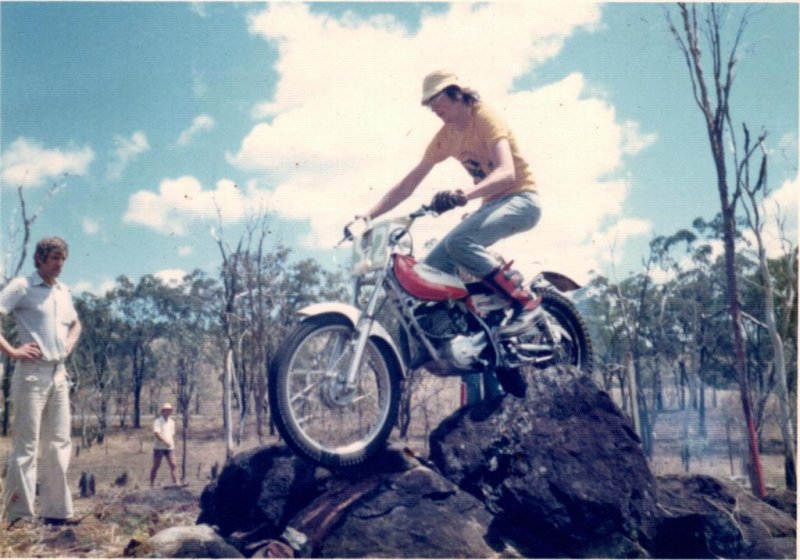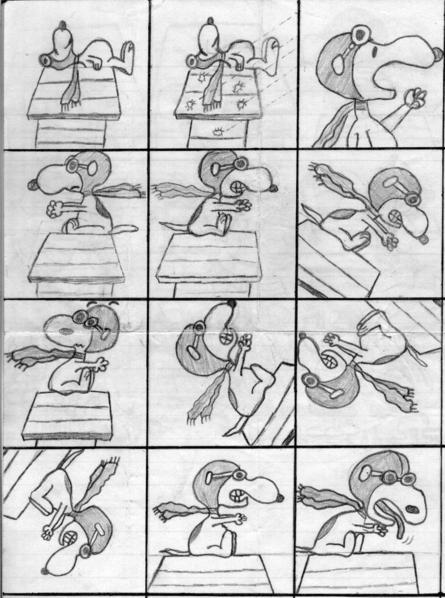-
Posts
125 -
Joined
-
Last visited
-
Days Won
2
Content Type
Profiles
Forums
Gallery
Downloads
Blogs
Events
Store
Aircraft
Resources
Tutorials
Articles
Classifieds
Movies
Books
Community Map
Quizzes
Posts posted by Eric McCandless
-
-
Congratulations Ayavner. Well done and enjoy!
-
 1
1
-
-
-
Congratulations Mothra. Its a great feeling to be finally there. Can you give us some details of your Nav test. Eric
-
Of the 5 that I have flown, in order of ease of flying:
1. Gazelle - can't imagine anything easier
2. Cessna 152
3. Warrior
4. Jabiru J170
5. Jabiru J230
-
Bikes owned:
- Matchless 500 road (first bike - pushed it more than rode it) (1970's)
- CZ 250 road (1970's)
- Suzuki T20 cafe racer (1972 - 1982)
- Yamaha 125 Trail (1972 - 1975)
- Yamaha TY175-JC Trials (x 3) - rode competition trials 1975 - 1983
- Yamaha YZ250 - rode competition moto-X and enduros 1983 - 1990
- Honda CB150 road - 2004 to current
Aircraft
- Hang Glider (1988 - 1990) - bent it and myself by crashing into a house
- Jabiru J170-C (2011 - current)
Exotic Cars - ok so no Lamborghini's (so far)
- Messerschmitt KR175 & KR200 micro cars (1975 - 1985)
- Hemi Pacer 265 Speedway Fender Bender (1983 - 1985)
- Mustang GT (2004 - 2008)
Machinery
- CASE 580D Loader / Backhoe (just purchased)
- Matchless 500 road (first bike - pushed it more than rode it) (1970's)
-
Awesome. Congratulations. If like me, it's a great feeling that is difficult to describe.
-
Yes agree, the breakeven point for owning vs hiring my J170 is about 140 hours per year. I did the sums before buying my aircraft to justify ownership vs hiring and decided that the spreadsheet must be wrong so I threw the spreadsheet out and went with my heart instead. Baked beans on toast for 3 meals a day so I can fund my habit ain't so bad. Eric....Do the calculation again using 100 hrs per year and see how you get economies of scale. -
I can't do that in my Jabiru. Even when trimmed, the moment I take my hand off the controls it takes a random change in direction and attitude/altitude/speed. If I spend too much time with my head down doing calcs, I can find I am 15 degrees off course and (usually) descending about to enter a spiral dive (some exaggeration perhaps).A well trimmed plane can manage itself for a few seconds when notes are writtenAs a low time pilot, I am continually refining and improving my cockpit management. I gave up on trying to use a knee board and have now settled on resting a cheap plastic A4 clipboard on my lap with pouch for protractor/ruler and marker pens. Without a passenger it is easier to manage because the spare seat acts as office space. My flight plan is clipped to the clipboard which then usually sits on my lap and my chart is folded (sometimes with help of some tape) and either sits on my lap on top of the clipboard or I place it on the passenger seat when I don't need it. I have arranged the flight plan template so I only need to write on the right hand side of the page. I keep the wizz-wheel (out of its sleeve) in the LH door side pocket and the pens/markers on top of the dash (I haven't got around to a pen holder). My charts are covered in adhesive plastic and I use permanent markers (which can subsequently be erased with Avgas or turps) to write as much as I can on the chart including headings, area and CTAF frequency changes, AWIS freqs, position check points, altitudes, and wind directions so I minimise switching between chart and plan. I write time on the chart with marker pens when I have confirmed my position.
Because of the central control column on the J170, and as I am right handed I tried writing with my left hand but gave that up as almost impossible, so now I cross arms when I have to and fly the plane with my left and write with my right. Eric
-
 1
1
-
-
Hi OME, Thanks and I did understand your question which I think I responded to in my first post. The point of my second post was to demonstrate why I think the original calculation doesn't mean anything as I can't see how one cannot consider other costs as these are what comes out of our pockets to get from A to B. I think it would be more useful to do a comparison based on all costs. Each aircraft will have different operating and maintenance costs. However as aircraft owners each have different use and maintenance profiles, perhaps the best way would be not to base calculations on owners costs but on average wet hire rates. A J170 based on hire rates is shown below. If you have a specific purpose for not including these other costs, then sorry I have missed the point and I don't wish to hijack your thread. Thanks. Eric.
-
This is probably more representative of my J170 aircraft ownership costs and cost per seat mile (too scary to think about too much).
Of course the costs would be different for hiring (a lot cheaper in my case).
Aircraft Operating Costs Units per year Cost per hour
Flying Hours (per year) 50
Cruise Speed (knots) 95
Number of Seats 2
Non-Cash Costs
Aircraft Value $65,000
Opportunity Cost of Money (% / year) 6.00% $3,900 $78
Depreciation (per year) $3,000 $3,000 $60
Cash Costs
Registration $130 $130 $3
Insurance $2,600 $2,600 $52
Engine Overhaul Cost $10,000 $500 $10
Engine overhaul Hours 1,000
Engine top end overhaul cost $3,000 $300 $6
Engine Top Overhaul Hours 500
Propeller replacement cost $1,500 $75 $2
Propeller replacement Hours 1,000
25 hour Oil & Filter Change (L2) $100 $200 $4
100 hourly (L2) $500 $250 $5
Maintenance (ADs, tyres, Instruments, Misc) $500 $500 $10
Hangar hire (month) $190 $2,280 $46
Fuel consumption (litres / hr) 15 $1,500 $30
Fuel cost (per litre) $2.00
Oil consumption per hour (ml) 50 $25 $1
Oil cost (per litre) $10.00
Landing fees per year $800 $800 $16
Total Cost $16,060 $321
Cost per mile $3.38
Cost per seat mile $1.69
Eric
operating and maintenance costs per seat mile.xls
operating and maintenance costs per seat mile.xls
-
 1
1
-
-
Jabiru J170
Fuel Consumption 15 Ltr/Hr
Oil Consumption 50 ml/hr
Cruise Speed 95 knots
Fuel Cost $2.00 /ltr
Oil Cost $10.00 /ltr
cost per mile $0.32 per NM
cost per seat mile $0.16 per seat NM
I have attached a spreadsheet for others to use to calculate if they wish.
However I don't think these figures mean anything in the real world as ownership and maintenance costs should be also considered which would change the outcome considerably.
P.S. I wish I could buy Avgas for $2.00 per litre and oil for $10 per litre.
Eric
-
Thanks everyone for the suggestions. I now have a good selection of options. I would love to do the Victor 1 but out of my league at present I think. Eric
-
Ayavner, thanks for the kind words. Since getting my Nav endorsement, I have been flying the wings off my Jabiru (one of the advantages of owning vs hiring). I have been gradually extending my range and comfort zone. I still have a long way to go but with every flight I am feeling more confident (and hopefully more competent). I have yet to take a passenger and my elderly Mum will be my first PAX in just over a week. My training diary has completed but I may write up my trips in a blog some day as I am keeping the records. But it used to take me about ten hours to write up a one hour lesson and I have been too busy lately.... Great to hear from you Eric as well, as I know you have just gone through this recently so would still be fresh in your mind... have you done much flying? any new write-ups or a blog planned? It was great reading about your journey, made a big difference on mine!Good luck with your test, but you won't need luck because as others have said, your instructor will not take you unless they think you are ready. Your instructor does not want you to fail and they will also take into account that you may be nervous. Just treat it as another lesson, relax, and enjoy. The feeling of freedom when you get your wings is awesome. Eric
-
 2
2
-
-
Thank you. The link did not work for me, but I found the document on the CASA site. That route looks awesome and I would love to do it. I would need to drag my instructor along for the first time (at least). Thanks a lot. EricThe details are in the link I posted (from page 58 onwards), have fun!
-
Get a good night's sleep (if you can, I couldn't) so you will be rested beforehand. I was pretty uptight about my test until I got into the aircraft and then I relaxed (somewhat). Just try to relax and do what you have done previously with the instructor and solo. Just think of it as another dual flight and do what you have done many times before. Focus on being precise but don't obsess about it. If you do make a mistake, don't dwell on it as it will affect your next move. Have fun and enjoy. When you land and learn that you passed, the adrenalin and euphoria will kick in and it will feel almost as good as your first solo. Eric
-
 2
2
-
-
Hi 68volksy, thanks for the suggestions. I may have to talk to my instructor to work out how to avoid controlled airspace and maintain step separation around Lake George and fly at a safe height. My understanding is that I would need to keep 2 nm from the step boundary between 2001-5000 feet. Looks a bit tricky to me. EricNot necessarily picturesque (or very far) but I love flying over Woodlawn mine and the wind farm. Currandooley homestead is quite the manor and Lake George still has some water in it too... -
Thanks for the suggestion HH, but what do you mean by "On number 3, keep going North to Victor one!"?On number 3, keep going North to Victor one! -
As a low time pilot with my recent RAAus Nav and PAX endorsement, I wish to take my 84 year old (and partially disabled) Mum on some scenic trips within about 100nm radius around Goulburn over a 12 day visit (from Queensland). She is very keen to go on some trips, but has never been in a light aircraft before and so I will start small and gradually work up to some longer trips and see how she goes.
I don't wish to go over too much tiger country (which unfortunately seems to be where all the scenery is). My plan so far is (all these places I have been before except Wollongong / Batemans Bay / Tuross Head):
- Goulburn training area - Lake Bathurst - Goulburn sightseeing
- Goulburn – Crookwell – Gunning - Goulburn
- Goulburn - Wollongong - Mittagong - Goulburn
- Goulburn - Cowra - Young - Gundagai - Lake Burrinjuck - Goulburn
- Goulburn – Moruya - Batemans Bay - Tuross Head - Moruya - Goulburn
Any suggestions?
Eric
- Goulburn training area - Lake Bathurst - Goulburn sightseeing
-
I've also thought the same thing. Surely it would save tyre wear and thus money.
-
-
Sorry I may not have explained what I mean well enough. I don't have a lot of flying experience. There is discussion (in another thread) of not using too much aileron into a turn onto final and always maintaining a balanced turn using rudder.Hi Eric,I think you are asking what is the likelihood of and what happens if you reach past the stall stick position whilst deliberately sideslipping , for example, whilst trying to lose height during an approach.When I did my tail wheel endorsement on the super cub at Aldinga this was discussed and attempted whilst practising sideslipping at considerable altitude. The cub virtually refused to stall so was not a problem however djpacro may be able to enlighten us as to the outcome in less docile aircraft
Cheers Peter
A sideslip is a common technique for a crosswind landing. In a strong crosswind landing, I have used significant aileron and opposite rudder whilst flying at a relatively slow approach speed.I understand that when slipping the airspeed is actually higher than indicated due to the angle of incidence of the airspeed pitot tube to the airflow, so this establishes some safety margin.
Given that if I wasn't using opposite rudder to establish a slip, I would be turning as I am using opposite rudder to counteract the banking turn. How much more unbalanced can you be when using a high degree of into the wind aileron and opposite rudder? Isn't this the same as an unbalanced turn?
I suppose the airspeed over both wings would be the same in a slip, as opposed to when in a turn where the airflow is slightly lower for the inboard wing. But due to asymmetry of the airflow, would either wing be closer to stall than the other with potentially the same dangerous consequences as when turning?
Also when the crosswind is gusting, there is a need to sometimes use significant aileron (and rudder) movements, which if in a turn should be completely avoided. I am very conscious of steep banking and maintaining balance during slow speed banking turns, but less so when slipping. Should the same caution be exercised when in a slip?
-
Depends how a spin is defined. I am talking about one wing stalling before the other causing the aircraft to pitch towards the ground. If one wing stalls before the other, then that may lead to a spin won't it? EricYou mean a spin? -
I find it very difficult to get a good heading reference with my compass as it seems to be very sensitive to aircraft movement due to turbulence (even mild) and also during climbing and descending (cheap Jabiru compass???). So I do try to pick a point on the horizon and fly towards that. However, with a 10 degree crosswind correction such as I had on a recent nav, if I were to fly toward that distant point, I would be flying an ellipitcal path off my intended track.You are not on rails. You won't do it by watching the magnetic compass. A lot of them are not damped well and don't have a strong enough magnet. they respond to turning and acceleration errors.. In any case the earth's magnetic field is weak.Pick a point a good distance away, and keep it in the same relation to the nose. If you have a good indicator of track, (like GPS or VOR) refer to the indication occasionally and adjust where your nose is to regain track. If you are IFR you then fly on instruments ( YOU won't be) and if you are navigating VFR refer to features, map read, refer to compass when steady, and backup with GPS etc if you have it. to confirm position. NevSo instead, with say a 10 degree crosswind, I should not be steering towards that distant point, but using a 10 degree offset to the longitudinal axis, and thus effectively panning across that distant point to maintain a straight track? I haven't tried it, but what about using an aim point 10 degrees to the left or right of the longitudinal axis? Eric
-
Another thread discusses stalls and turning, which I found very informative.
But what about potential for stalls during intentional slips?
The importance of a balanced turn is emphasised, but in a slip the aircraft is intentionally unbalanced.
How does that affect the propensity for a wing stall? Will one wing tend to stall before the other, for example if more or less aileron is suddenly applied to make a change to the amount of slip and the airspeed is too low? Eric






Flyable Hours
in AUS/NZ General Discussion
Posted
I was doing some spreadsheet calculations on the difference in the length of the day from first light to last light for different times of the year and found it interesting how the length of the flyable day varies significantly with season and latitude. For example Hobart gets more flyable hours than Cairns (both in summer and yearly total). Also interesting how twice a year, the length of the flyable day is exactly the same for all locations. Eric